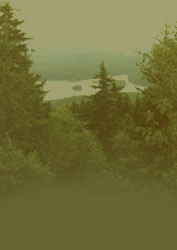|
Do you have something
happening in your corner of Washington? - Please call a member
or e-mail your observations to have them included here
November:

Environmental Podcasts! Are you listening?
New Hampshire Public Radio has several environmental podcasts that you can listen to if you miss the original broadcasts on the radio. You will learn some wonderful things about the natural world by listening. These are produced in New Hampshire and focus on the state’s nature and wildlife.
You can find information about them by clicking on the links below and download the podcasts from the Apple iTunes store (they are free!)
Outside/In is a show about the natural world and how we use it. Host Sam Evans-Brown combines solid reporting and long-form narrative storytelling to bring the outdoors to you wherever you are. You don’t have to be a whitewater kayaker, an obsessive composter, or a conservation biologist to love Outside/In. It’s a show for anyone who has ever been outdoors. In short, it’s a show for *almost* everyone.
Link to Outside/In
Something Wild has been exploring the wonder of the landscape that surrounds us in New Hampshire for 20 years!
The show broadcasts every other Friday on Morning Edition at 6:45am and again at 8:45am
From the many birds that call our state home to the trees around New Hampshire that have been granted "Big Trees" status to stone walls that perforate the state, we explain the behavior and science behind what we see and hear and might take for granted in our backyards.
Something Wild is hosted by the Forest Society’s Dave Anderson and NH Audubon’s Chris Martin and is produced by Andrew Parrella.
Link to Something Wild
Ask Sam features Outside/In host Sam Evans-Brown answering listener questions about the mysteries and quirks of the natural world.
Do you have a question you want Sam to answer on NHPR's Morning Edition? Call the Outside/In hotline at 1-844-GO-OTTER or email a voice memo to outsidein@nhpr.org.
Link to Ask Sam
Listen in and enjoy these Podcasts!
October:
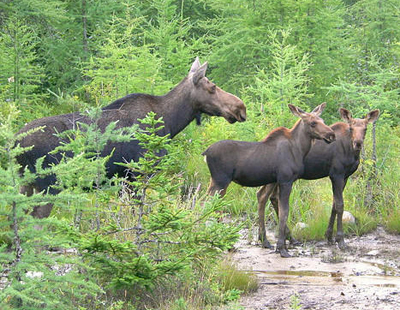
Picture by Northeast Naturalist via Flikr CC
A North Country icon, the moose, is becoming a "poster child for climate change"
As New England winters warm, fall lingers longer and spring comes into bloom earlier, regions like northern New Hampshire and western Maine are seeing an unusual continued increase in winter ticks, which are endangering the moose population. UNH researchers have found that the swell of infestations of this parasite, which attaches itself to moose by the tens of thousands during the fall and feeds throughout the winter, is the primary cause of an unprecedented 70 percent death rate of calves over a three-year period.
“The iconic moose is rapidly becoming the new poster child for climate change in parts of the Northeast,” said Pete Pekins, professor of wildlife ecology. “Normally anything over a 50 percent death rate would concern us, but at 70 percent, we are looking at a real problem in the moose population.” Moose are a major driver of tourism in northern New Hampshire.
In the study, published in the Canadian Journal of Zoology, researchers outline the screening of 179 radio-marked moose calves (age 9 to 10 months) for physical condition and parasites in the month of January over three consecutive years from 2014 to 2016. They tracked new calves for four months each winter and found that a total of 125 calves died over the three-year period. A high infestation of winter ticks was found on each calf (an average of 47,371 per moose) causing emaciation and severe metabolic imbalance from blood loss, which was the primary cause of death.
Most adult moose survived but were still severely compromised. They were thin and anemic from losing so much blood. The ticks appear to be harming reproductive health so there is also less breeding.
The researchers say winter tick epidemics typically last one to two years. But five of the last 10 years have shown a rare frequency of tick infestations, reflecting the influence of climate change. Researchers point out that right now these issues are mostly appearing in southern moose populations, but as climate change progresses they anticipate this issue to reach farther north.
“We’re sitting on a powder keg,” said Pekins. “The changing environmental conditions associated with climate change are increasing and are favorable for winter ticks, specifically later-starting winters that lengthen the autumnal questing period for ticks. Fall is considered “questing” season for winter ticks. They climb up vegetation and look to attach to a host. Once they attach, they go through three active life stages (larvae, nymph and adult) by taking a blood meal and feeding on the same animal. The ticks will feed and remain on one host during their subsequent molts until spring when adult females detach and drop to the ground. Their preferred hosts are moose and other mammals, including deer, elk, caribou and occasionally horses and cattle. Winter ticks rarely bite and feed on humans.
Co-authors include Henry Jones and Daniel Ellingwood, both of UNH, Lee Kantar and Matthew O’Neal of the Maine Department of Inland Fisheries and Wildlife, Inga Sidor of the New Hampshire Veterinary Diagnostic Laboratory at UNH, and Anne Lichtenwalner of the University of Maine Animal Health Laboratory.
Funding was provided through New Hampshire Fish and Game and Maine Inland Fisheries and Wildlife in cooperation with the U.S. Fish and Wildlife Service Division of Wildlife and Sportfish Restoration, UNH and the Safari Club International Foundation.
Information found at: UNH
September:
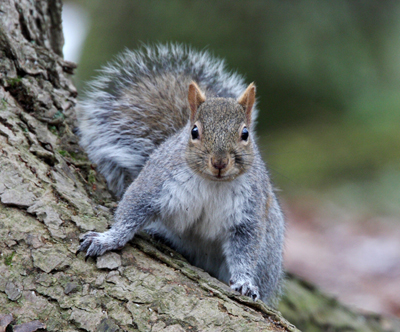
Picture by Jacob Dingel
I’m sure you have noticed the large numbers of squirrels around this year and maybe wondered what is going on. A big crop of acorns, pinecones and other staples last year led to an “irruption“ or boom in the population of small rodents including squirrels.
You have probably also noticed the large number squirrels darting out in the road and resulting road kill. The early summer drought lead to a much smaller crop of acorns this year, leading to a lot of hungry squirrels in search of nutrition and food sources and and exhibiting erratic behavior. Without their usual foods in abundance they have taken to eating whatever they can find. Farmers have suffered crop losses as squirrels have taken to eating corn right off the stalk, fruit off the tree and pumpkins still in the pumpkin patch.
Boom years are uncommon so the population should return to normal soon and sadly the culling has already started with all the road kill we observe on the sides of the roads. Luckily the scavengers such as ravens, crows and turkey vultures will be happy to do the required clean up work.
August:

We are all for composting at home but if you don’t have the room or inclination to do it on your own a great alternative is the Washington Transfer Station Composting Program!
This program has been going on for years but we think a lot of people don’t know about it. If you don’t have room to compost at home you can still participate by bringing your kitchen waste and green yard waste and leaves to the transfer station to compost. This helps save the town money in dumping fees that have risen quite dramatically in the last few years. Almost 40% of the trash can be composted. If you throw this organic waste in the dumpster it costs money, we pay $42 a ton for trash that goes to the incinerator.
Here is what is accepted for composting:
Leaves and yard waste (grass clippings, plant greens, garden waste) no branches – those are accepted in another spot.
Kitchen waste – no bones, meat, fat or animal waste (no cat litter or dog or cat waste)
The composting bin area is found past the mall and on the right (an open, large 3-sided concrete structure).
The more composted material is on the right and newer material should be dumped on the left side of the bin.
The transfer station has finished compost available and is free for the taking. The compost is piled across the way above the mall area, just ask the attendant about it. There are so many great uses for the finished compost. You can use it to amend your soil by adding it to the soil in your pots or garden and use it to feed your plants and lawn in the spring.
We are working with Ed to make some new signs for the transfer station and composting area and a brochure to promote town wide composting. We will get some more information on the website also, to help spread the word.
Call Ed (495-3641) or talk to the person on duty at the transfer station if you have any questions.
Ed also has a couple of backyard composting bins for sale for $50 at the transfer station.
July:

Picture by Jed Schwartz
Do you enjoy fresh vegetables, berries and fruit during the growing season?
If you have the space on your property and have a garden, berry plants and fruiting trees you are in heaven this time of year. Sure, it is some work but the benefits are hard to beat.
If you don’t have the space for a garden at home you might consider joining the group of gardeners at the Community Garden behind the Town Hall. This community garden was started years ago and is thriving right in the middle of town. There is always room for a few more gardeners, so if you are interested contact Arin Mills about joining next season.
If you don’t have the urge to grow your own you should visit the Washington Farmer’s Market every Saturday from May to October. There are delicious vegetables, fruit and berries available, along with baked goods, jams and jellies and many more treats.
The Eccardt Farm’s farm store is the place to go for high quality raw milk, farm grown meats, eggs, ice cream and much more. It is open year round and we consider this dairy farm a local treasure! Visit the animals and buy your food supplies. Need compost for your gardens? They’ve got you covered!
If you want to pick your own blueberries visit the Halfmoon Farm on Halfmoon Pond Road, this time of year there are gallons of berries to pick!
Eat well, keep a garden and support your local farmers!
June:
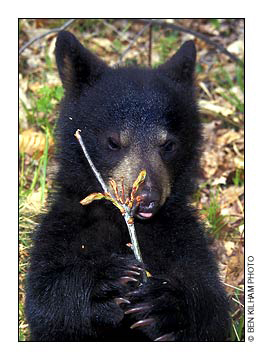
Picture by Ben Kilham
The USDA Wildlife Services works closely with the NH Fish and Game Department to mitigate human-bear conflicts throughout the state.
Prime black bear habitat includes deciduous forests (oaks, maple, beech etc.), wetlands, and riparian (along rivers) zones. The natural areas surrounding our town provide very good habitat for black bears. Many human-bear conflicts arise when bears frequent properties to access food attractants that are found around homes. The most common attractants are birdfeeders, unsecured garbage, and compost piles which include food scraps. Livestock, such as chickens and pigs, can also attract bears when not properly protected. Electric fencing is the most effective way to protect livestock. In most cases removing the attractant the bear(s) are utilizing eliminates the bear problem. It is also helpful to harass bears with noise, such as banging pots and pans, or using compressed air horns to scare them away.
The following are links to valuable information on Black Bears:
NH Fish and Game Bears
NH Fish and Game Black Bear FAQs
NH Fish and Game Black Bear Profile
NH Fish and Game Help with Bears
Information on Bears & Chickens:
Movie about Securing Chickens from Bears
Information on Bears & Birdfeeders:
Movie about Bears and Birdfeeders
Information on Dumpsters:
Movie about Bears and Dumpsters
Information on Dumpsters 2:
Another movie about Bears and Dumpsters
May:
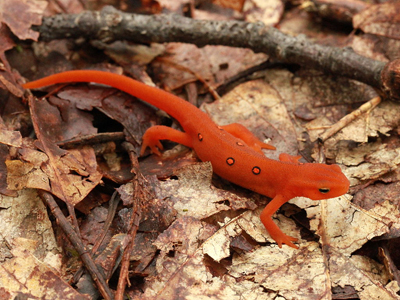
Picture by Brian Gratwicke
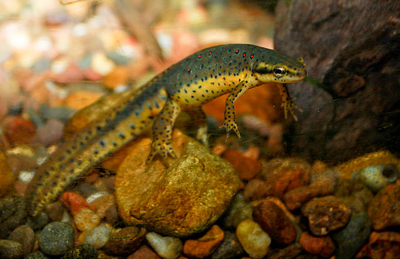
Picture by Jason Quinn
Red Eft & Red-Spotted Newt - same creature different lives - Notophthalmus viridescens
The Eastern Newt is unique in that they undergo two metamorphoses. The first is the usual transformation from aquatic, gilled larva to an air-breathing terrestrial form. Three or four months following hatching, the larva loses its gills, develops lungs, and begins life on land as a Red Eft. Efts usually reach about 3 inches in size.
During the next two to three years, it will forage on the forest floor, often wandering about boldly during the day, especially during or just after a rain. Although it is conspicuous during this red eft stage, other animals seldom bother it because its skin glands produce irritating secretions and their bright coloration serves as a warning.
During the third year of its life, a remarkable transition occurs. The skin becomes slimy and changes from orange to olive green. The tail becomes broad and wedge-shaped, and the body looks more like that of a salamander than a lizard. At this point, the salamander returns to water to breed and remains there for the rest of its life as a mature red-spotted newt. Adults reach lengths of nearly 5 inches.
Newts occur sporadically throughout our state in permanent or semi-permanent bodies of water bordered by relatively undisturbed woodlands. Keep your eye out for the Red Efts on the land or Red Spotted Newts in the water.
Information found at: Ohio Department of Natural Resources, Division of Wildlife and USGS Northern Prairie Wildlife Research Center
April:
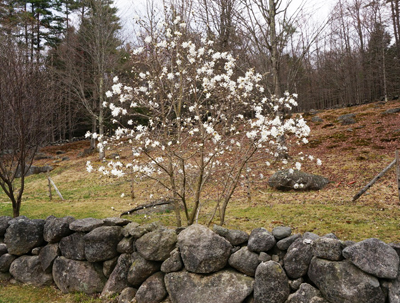
Picture by Jed Schwartz
Is it Spring or not? April has been a crazy month with signs of spring and then measurable snow to dash our hopes. Sugaring season was extra long this year with a yield to match. There was the perfect balance of subfreezing temperatures at night and warm ups during the days that just went on and on. The snow didn’t want to stop falling and only some of our lakes and ponds are free of ice.
The vernal pools weren’t thawed enough to welcome frogs and salamanders to mate and lay their eggs in the last few weeks. Maybe this week of warmer weather will bring suitable conditions for their annual ritual. Listen for the spring peepers and watch out for salamanders and frogs crossing the road!
The migrating song birds are showing up and you can hear their songs fill the morning air. Robins have arrived and are looking for worms. Bluebirds are checking out the nest boxes and getting ready for raising a brood. Ducks and geese are visiting the open water.
Trees are starting to bud out but it has been a slow start. At least when the sun does shine it gives off lots of warmth and melts the late snow, greening up the grass and giving us hope that winter is finally over.
March:
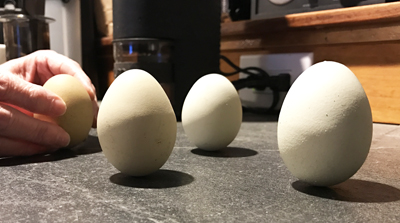
Picture by Jed Schwartz
It’s finally spring, even though there is still lots of snow and freezing weather around! The Vernal (Spring) Equinox took place Tuesday, March 20, 2018 at 12:15 pm. The Vernal equinox is taken to mark the beginning of spring and the end of winter in the Norther Hemisphere. On the day of an equinox, daytime and nighttime are of approximately equal duration all over the planet. This marks the point when the Northern Hemisphere starts to tilt toward the sun, which means longer sunnier days.
The word equinox comes from Latin words which literally means “equal night”—aequus (equal) and nox (night). Equinoxes Vernal and Autumnal) are the only two times a year that Sun rises due east and sets due west for all of us on Earth!
In the Northern Hemisphere, the Vernal (Spring) Equinox marks the first day of astronomical spring, which ends on the June solstice, when astronomical summer begins. There's a more common definition of when the seasons start, (meteorological definitions), which are based on average temperatures rather that astronomical events. For meteorologists, spring in the Northern Hemisphere begins three weeks before the March equinox on March 1 and ends on May 31.
Many cultures around the world hold feasts and celebrate festivals and holidays to mark the March Equinox. The date of the March Equinox plays a huge role in calculating the dates for when to celebrate Jewish Passover and Christian Easter. Easter always falls on the first Sunday after the first full moon after the Vernal equinox.
Early Egyptians even built the Great Sphinx so that it points directly toward the rising Sun on the day of the vernal equinox.
The Iranian New Year (Nowruz, No-Ruz, No-Rooz or No Ruz) occurs during the time of the March Equinox, in accordance with the Persian astronomical calendar.
In Japan, people Remember their Ancestors, Higan (Higan-e or Ohigan), is a week of Buddhist services during the March and September Equinox. Both equinoxes are national holidays since the Meiji period (1868-1912). "Higan" means the “other shore” and refers to dead spirits who reach Nirvana after crossing the river of existence. It celebrates the spiritual move from the world of suffering to the world of enlightenment.
An ancient Chinese tradition calls for balancing eggs on end, a symbol of fertility, on the day of the March Equinox for good luck and prosperity. Many people think the equinox is the only day you can balance an egg on its end but actually if you are patient you can do it any day of the year.
Happy Spring!
Information found at: Wikipaedia and TimeandDate.com
February:
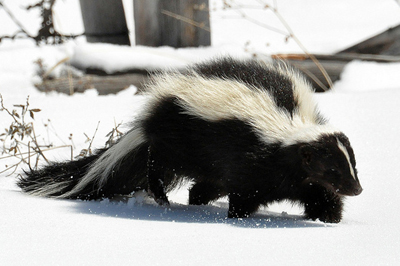
Picture by: Dan Dzurisin, NDomer73
Several of us have seen striped skunks wandering around in the evening light. What are they doing out there with snow still on the ground and cold weather the norm?
In, New Hampshire striped skunks typically spend the winter months hunkered down in earthen dens. While they don’t fully hibernate, they are mostly inactive in the winter, surviving off of thick layers they accumulated during the summer and fall. Skunks will wake up periodically throughout the winter, and if the temperatures are warm enough, they will venture out to scavenge. Winter fare is usually pretty scarce, leaving skunks to feed on carrion, fruit, seeds and occasionally the offerings of backyard compost piles.
This time of year is skunk breeding season. Striped skunks mate from mid-February through mid-March. Generally skunks will stay in their burrows until the first streak of warm weather in February. Warmer temperatures draw them out of their dens and set them looking for mates. Male skunks are especially mobile as they search for females in their territory.
Skunks usually only spray as the last resort. When a skunk feels threatened, it will normally try to run away. If this method is unsuccessful it may then try to scare away the predator by turning its back, raising its tail, and sometimes even stomping its feet. If all else fails, the skunk will release its infamous, strong-smelling spray in the direction of the predator.
The takeaway message is this: if you see a skunk wandering around this time of year, don’t worry - just give him space as he looks for love.
Article by Emily Erler, UNH Extension Education Center Coordinator and found at: UNH Extension Education Center
January:
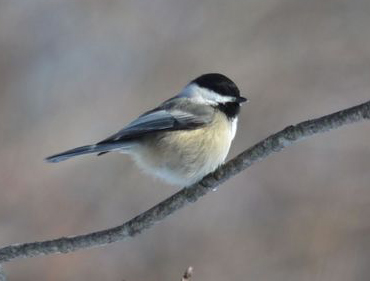
Picture found at: birdingnh.com
Many people reported that birds disappeared from their feeders in the fall and NH Audubon wants to know if they have returned with the cold weather. Help track our bird populations by taking part in the annual Backyard Winter Bird Survey on Saturday, February 10 and Sunday, February 11. Biologists need assistance from citizens all over the Granite State to get a clear picture of what’s been happening with our winter birds.
This fall there were exceptionally good natural food crops of berries, seeds, nuts, and cones. The birds took advantage of this natural bounty and, combined with the mild fall weather, spent more time in the woods, often ignoring feeders entirely. Woodpeckers seemed to be the first to return to feeders followed gradually by other species. Christmas Bird Count data are beginning to come in and first indications are that the number of most feeder birds is average with one exception – Black-capped Chickadee. This is one of our most common feeder birds and its absence is especially noticeable.
So where are all the chickadees? NH Audubon doesn’t know of any mortality event that would have reduced the population, and the timing of their initial disappearance in the fall indicates two possibilities – either the chickadees in Canada never came south because of good local food supplies, or chickadees left our state in the fall for points south. Some birds we think of as year-round residents, including chickadees, Blue Jays, and House Finch, migrate in some years. Occasionally they move south in response to food supplies or weather cues we can’t detect. Some species, such as American Goldfinch, are nomadic, following food sources over a large region and we have years with many goldfinch and other years with none. On the plus side, signs are that it is a record-breaking winter for Dark-eyed Juncos with many Christmas Bird Counts reporting record high numbers.
NH Audubon needs your help to track chickadees, juncos and other feeder birds. Anyone can participate in the Backyard Winter Bird Survey by counting the birds in their own backyard on the survey weekend and reporting online or sending the results on a special reporting form to NH Audubon. To receive a copy of the reporting form and complete instructions, email your name and address to bwbs@nhaudubon.org or call 603-224-9909. Forms are also available at NH Audubon centers in Auburn, Concord and Manchester, and online. Find more information about the survey at www.nhaudubon.org under Get Outside-Birding.
Reports of a lack of birds are just as valuable as reports of many birds. “If everyone reported only when they have a lot of birds, we wouldn’t be able to see the declines,” says Suomala. The most important thing is to participate each year regardless of how many or how few birds you have. This provides a consistent long-term set of data that shows both the ups and downs.
All New Hampshire residents are encouraged to take part. Results from past years are on the web site. For more information about the Backyard Winter Bird Survey, please call NH Audubon at 224-9909 or go to the web site at www.nhaudubon.org and click on Birding.
Information found at: NH Audubon.
To view yearly archives of our "New In
Nature" series click on year you wish to see.
2002
2003
2004
2005
2006
2007
2008
2009
2010
2011
2012
2013
2014
2015
2016
2017
|


